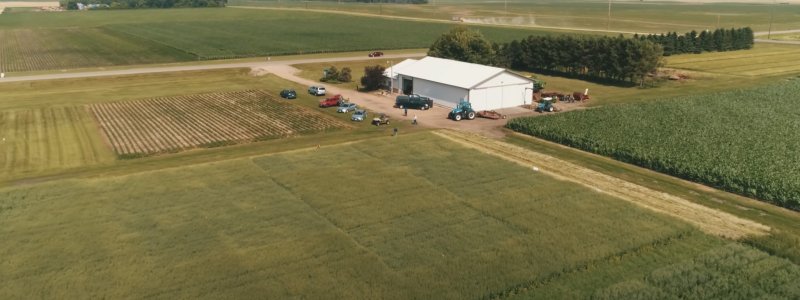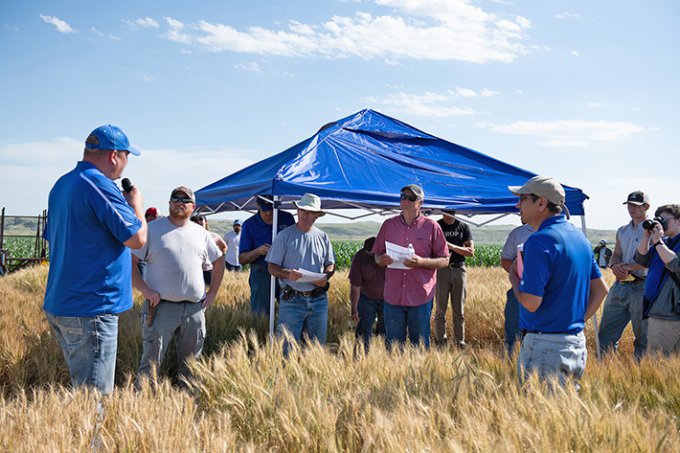Northeast Research Farm Mission
The overall mission of this research station is to provide an environment conducive to research and extension activities in the plant sciences. This station also provides an additional platform for communication between area crop producers, stakeholders and university personnel, and aids in providing agronomic information applicable to Northeastern South Dakota.
About Northeast Research Farm
The Northeast Research Farm was established in 1956. It is located approximately 15 miles north of Watertown at the junction of Highway 20 and old Highway 81, or 2 miles west of the I-29 South Shore exit. This farm was originally one of several mobile units and intentions were to move to different locations every 6–10 years. However, a long-term lease arrangement with Orrin Korth has enabled the station to remain in place and increase in size from the original 20 acres to the current 93 total acres with 80 tillable acres.
Climatic conditions reflect the northeastern portion of the state; the growing season is shorter, nights are cooler and precipitation is significantly less than at Brookings. These conditions afford researchers an opportunity to test the adaptability of varieties and techniques to a much different climatic zone without excessive travel expenses. Other reasons for retention of the station include the remarkably uniform soils at this site. These uniform soils allow researchers to move to different areas on the station without having to contend with major differences in soil type.
Key Research Projects
The SDSU Hard Red Spring Wheat (HRSW) breeding and genetics program was initiated in 1977 and is housed on campus. However most of the important research results are gathered from trials conducted throughout the HRSW growing region of the state. Because abiotic stresses, such as heat and drought, often progress from south to north during summer months, this program has a unique ability to identify commercially valuable germplasm that performs well under conditions that are generally more hot and dry than where other HRSW breeding programs operate. Because of the abiotic stress characteristics associated with selection environments, the SDSU HRSW breeding program consistently releases cultivars that are among the fastest in the nation to reach maturity.
Winter Wheat breeding program develops hard winter wheat varieties with excellent yield potential that provide increased resistance to diseases like fusarium head blight, stripe rust, and good winter hardiness along with desired end-use quality. The program has a 63-year history of releasing widely adapted hard winter wheat varieties. Some of the recently released hard red winter wheat from SDSU are ‘Winner’ and ‘Draper’ (2019), ‘SD Andes’ (2020), and ‘SD Midland’ (2021). SDSU varieties also do well in neighboring states like North Dakota and Minnesota. Fall-grown winter wheat captures snow/moisture, keeps ground covered/reduces soil erosion, and also living soil builds farm sustainability. Further, research has shown integrating fall-planted winter wheat in corn-soybean rotation can have additional yield advantages for corn.
The oat breeding program at SDSU has a long history of successfully releasing oat cultivars that are widely grown in and outside of South Dakota. Foundation seed of oat cultivars released by SDSU have been sold in Minnesota, Iowa, Michigan, Missouri, Nebraska, Kansas, North Dakota, New York, Wisconsin, Indiana, Maine, and Oklahoma in recent years. Over the last five years, four new oat cultivars (Hayden, Natty, Warrior and Saddle) were released by the South Dakota Agricultural Experiment Station and one variety (Sumo) was licensed to a seed company for oat production under organic management systems.
Small Grain Pathology program has been a great support to breeding programs in identifying lines with improved tolerance to many economically important diseases in South Dakota and surrounding region.
Watch our 2020 Virtual Field Day!

David Karki
SDSU Extension Agronomy Field Specialist
SDSU Extension
South Dakota Agricultural Experiment Station at SDSU
Department of Agronomy, Horticulture and Plant Science




